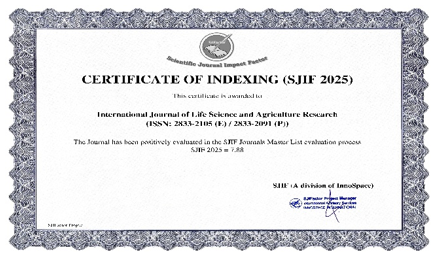Cultural Translatory of Horticulture Plants in Cold Lands and Cabapatenes
DOI:
https://doi.org/10.55677/ijlsar/V03I8Y2024-09Keywords:
Dry land, Horticulture, Horticultural_Cultivation, NgadaAbstract
Dry land is defined as an area of land that has never been filled or watered for most of the year. This type of land can be found from low plains (0–700 m dpl) to high plains (> 700 m dpl). Dry land is one of the resources that has great potential for agricultural development, including both food crops, horticulture, planting, farming, and fishing. The district of Ngada is one of the regions on the island of Flores that has a large area of dry land. This article aims to present the preservation of the cultivation of horticultural crops on dry land and hills, in particular in the territory of Ngada Regency. The method or approach of the study used in this study used the method or library approach (library research). The result is that horticultural commodity prospects are also highly strategic commodities and are continuously pushed to be able to improve the welfare of farmers and the economy. Innovative technologies are used for horticulture cultivation in dry land, such as the use of high-yielding cultivars suitable for dry land and their multiplication, water harvesting practices, integrated nutritional management, mulch, organic farming, and other technologies to improve storage capacity. Various barriers to horticultural cultivation on dry land can be overcome by applying horticultury cultivation technologies in dry lands that include horticultura cultivation through the application of organic fertilizers and bio-fertilizers, mulching, adjustment of planting patterns, and improvement of irrigation systems.
References
Abdurachman, A. A., Dariah, and A. Mulyani. (2008). Dry land management strategies and technologies support national food procurement. Journal of Agriculture, 27 (2): 43–49.
Ai Dariah, H. Suganda, E. Suyitno, S.H. Tala’ohu, and N. Sutrisno, 1995. Rehabilitation of Alang-alang land with a corridor cultivation system in Pakenjeng, Garut district. Procedure for the Technical Meeting on Soil Research and Agroclimate. Fields of Soil and Water Conservation, Agroclimat, pp. 31–41.
Alim Nurmaranti et al., 2022. Dry Land Management. Our Foundation Writing, 2022
Irawan, B., & Pranadji, T. (2016). Enabling dry land for sustainable agribusiness development Agroeconomic Research Forum. https://doi.org/10.21082/fae.v20n2.2002.60-76
Jayaputra, J. S. Horticulture Development in Dry Land and Environmentally Friendly Crop Technology Application to Increase Farmers' Income in Sukadana Village, North Lombok. Journal of Gema Ngabdi, Vol. 4, No. 3, November 2018.
Kumar, H., Singh, M. K., Gupta, M. P., & Madaan, J. (2020). Moving towards smart cities: Solutions that lead to the Smart City Transformation Framework. Technological Forecasting and Social Change, 153(October 2017), 1–16.
Matheus, R., Basri, M., Rompon, M. S., & Neonufa, N. (2017). Dry Land Agriculture Management Strategy for Improving Food Sustainability in East Nusa Tenggrara. Partner. https://doi.org/10.35726/jp.v22i2.246
Mulyono, D. (2010). Development of Alley Cropping for Critical Land Conservation in Hulu River Stream Area (DAS), Cimanuk, West Java. Journal of Environmental Engineering, Volume 11, No. 2, pp. 283-291. Jakarta.
Noywuli, N. 2023. Approaches to Conservation in Mountain Land Management for Agricultural Enterprises.
Noywuli, N., Limbu, U.N., Noa, M., Bhara, S.A., Bupu, Y. (2024). Analysis of Trouble in Dry Management and Hills in Ngada District, East Nusa Tenggara Indonesia. International Journal of Life Science and Agricultur Research, 3(7): 537-541
Pitaloka, D. 2018. Dry Grounds and Planting Patterns to Maintain Natural Sustainability. G-Tech Journal of Applied Technologies, Vol. 2, No. 1, October 2018.
Rizka Shafira, 2024. Dry Land Farming.
Solowey, E. M., Amede, T., Evans, A., Boelee, E., & Bindraban, P. (2013). Chapter 6: Drylands.
Utomo, M. 2002. Dry Land Management for Sustainable Agriculture. The paper was presented at the National Seminar on Dry Lands Development on May 27–28, 2002, at the Hotel Lombok Raya Mataram. Mataram, NTB Province
Zulkarnain. (2010). Horticultural Basics: Organic Agriculture. Jakarta: Earth Characters.
Downloads
Published
Issue
Section
License
Copyright (c) 2024 International Journal of Life Science and Agriculture Research

This work is licensed under a Creative Commons Attribution 4.0 International License.












